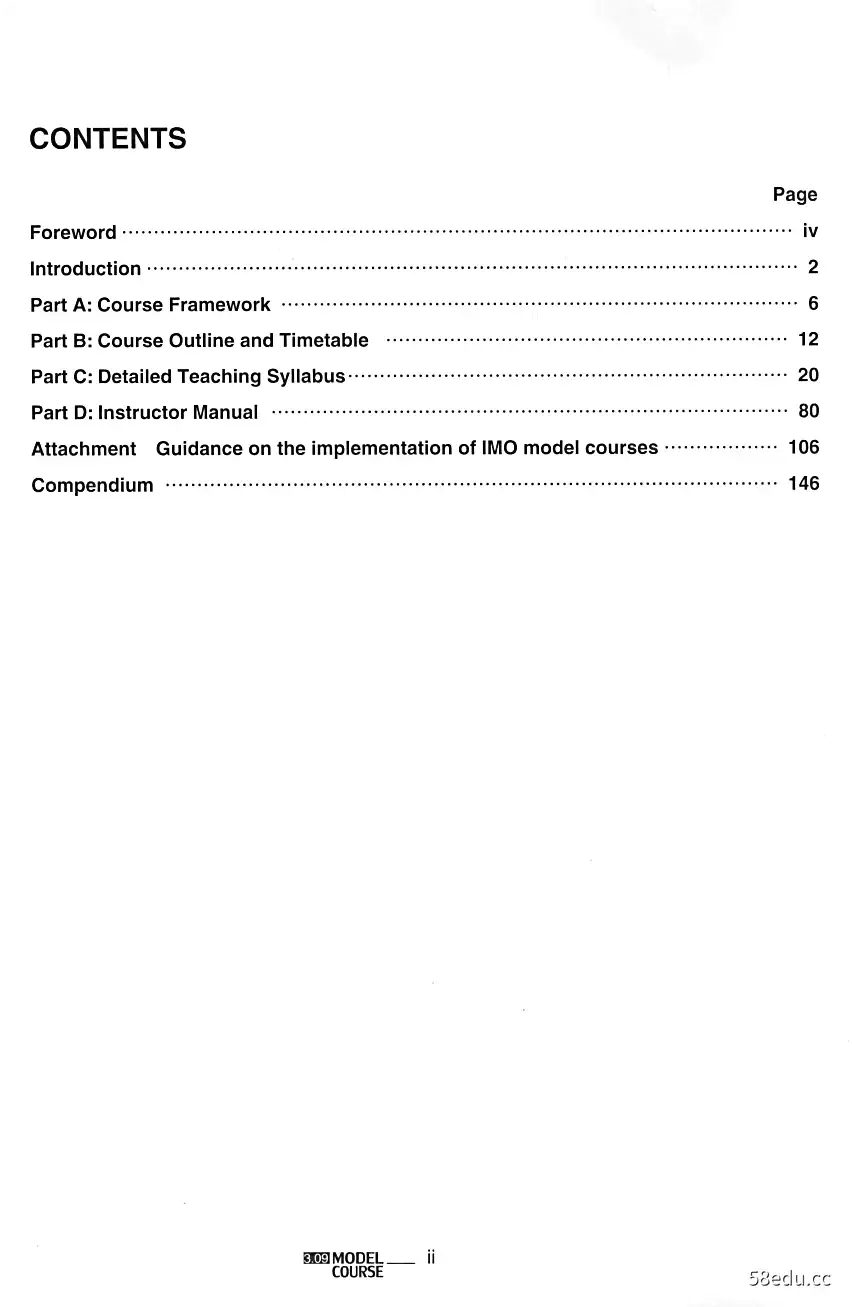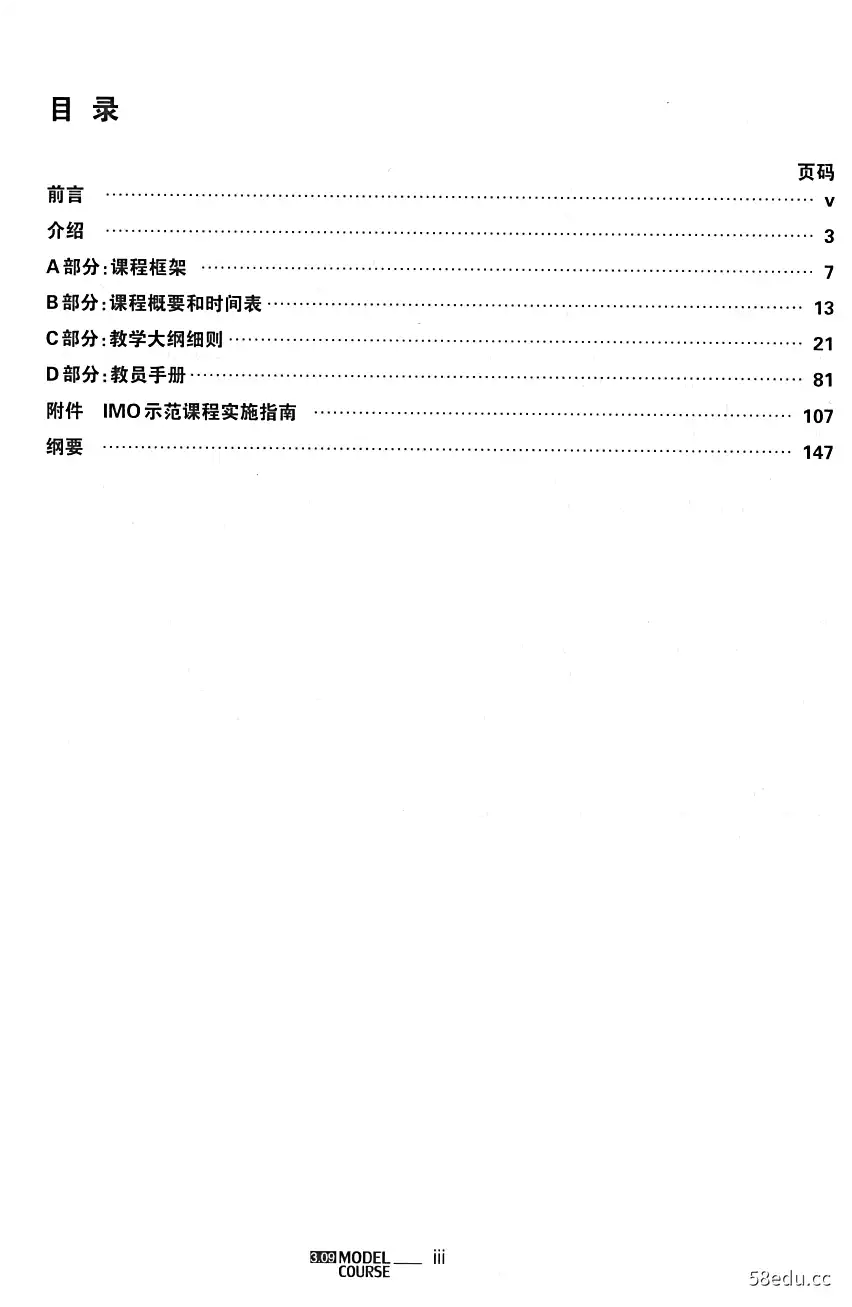《港口国监督 中英对照》国际海事组织著;中华人民共和国海事局译|(epub+azw3+mobi+pdf)电子书下载
图书名称:《港口国监督 中英对照》
- 【作 者】国际海事组织著;中华人民共和国海事局译
- 【丛书名】国际海事组织海员行为示范
- 【页 数】 531
- 【出版社】 大连:大连海事大学出版社 , 2016.06
- 【ISBN号】978-7-5632-3340-3
- 【价 格】85.00
- 【分 类】港务监督-技术培训-教材-汉英
- 【参考文献】 国际海事组织著;中华人民共和国海事局译. 港口国监督 中英对照. 大连:大连海事大学出版社, 2016.06.
图书封面:
图书目录:


《港口国监督 中英对照》内容提要:
本书为国家出版基金项目“国际海事组织海员行为示范”之一,根据国际海事组织海员行为示范课程MODELCOURSE3.09翻译而成。本书遵从IMO制定的培训课程,一方面,帮助《1978年海员培训、发证和值班标准国际公约》的实施以及对航海技术新发展方面的信息和技能的迅速转化;另一方面,还有助于教员改进现有课程的质量。对于航海类院校的各种培训有一定的实际意义。
《港口国监督 中英对照》内容试读
3.09 MODELCOURSE
港口国监督
Introduction
■
Purpose of the model courses
The purpose of the IMO model courses is to assist maritime training institutes and theirteaching staff in organizing and introducing new training courses,or in enhancing,updatingor supplementing existing training material where the quality and effectiveness of thetraining courses may thereby be improved.
It is not the intention of the model course programme to present instructors with a rigid“teaching package”which they are expected to“follow blindly”.Nor is it the intention tosubstitute audio-visual or "programmed"material for the instructor's presence.As in alltraining endeavours,the knowledge,skills and dedication of the instructors are the keycomponents in the transfer of knowledge and skills to those being trained through IMOmodel course material.
Because educational systems and the cultural backgrounds of trainees in maritime subjectsvary considerably from country to country,the model course material has been designed toidentify the basic entry requirements and trainee target group for each course in universallyapplicable terms,and to specify clearly the technical content and levels of knowledge and skillnecessary to meet the technical intent of IMO conventions and related recommendations.
Use of the model course
To use the model course,the instructor should review the course plan and detailed syllabus,taking into account the information provided under the entry standards specified in thecourse framework.The actual level of knowledge and skills and the prior technical educationof the trainees should be kept in mind during this review,and any areas within the detailedsyllabus which may cause difficulties because of differences between the actual trainee entrylevel and that assumed by the course designer should be identified.To compensate for suchdifferences,the instructor is expected to delete from the course,or reduce the emphasis on,items dealing with knowledge or skills already attained by the trainees.He should also identifyany academic knowledge,skills or technical training which they may not have acquired.
By analysing the detailed syllabus and the academic knowledge required to allow training inthe technical area to proceed,the instructor can design an appropriate pre-entry course or,alternatively,insert the elements of academic knowledge required to support the technicaltraining elements concerned at appropriate points within the technical course.
Adjustment of the course objective,scope and content may also be necessary if in yourmaritime industry the trainees completing the course are to undertake duties which differfrom the course objectives specified in the model course.
Within the course plan,the course designers have indicated their assessment of the timewhich should be allotted to each area of learning.However,it must be appreciated that theseallocations are arbitrary and assume that the trainees have fully met all entry requirements ofthe course.The instructor should therefore review these assessments and may need tore-allocate the time required to achieve each specific learning objective or training outcome.
309 MODEL
2
COURSE
介绍
介绍
示范课程的目的
MO示范课程的目的在于帮助海事培训机构及其培训人员组织和实施新的培训课程,或对
现有培训课程进行提高、更新或补充,从而可以改进培训课程的质量和有效性。
本示范课程既不试图给教员一个让他们“盲目追从”的死板的“教学文件包”,也不试图用视听或程序化课程材料来代替教员的存在。在所有培训工作中,教员的知识、技能和奉献精神,是
其通过MO示范课程将知识和技能传授给受训学员至关重要的因素。
由于在航海学科方面,学员的教育体制和文化背景在国与国之间有很大的不同,故对示范课程材料以普遍适用的术语进行了设计,确认每一课程的基本入门要求和学员目标组,并明确规定
其为满足MO公约及相关建议的技术要求所必需的技术内容、知识和技能水平。
示范课程的使用
为使用本课程,教员应对课程计划和教学大纲细则进行审查,并对规定于课程框架中的入门标准所提供的资料予以考虑。在审查过程中,应牢记学员的实际知识和技能水平及已接受的技术教育,并且对于教学大纲细则中因学员实际入学水平与课程设计人员推测水平之间可能带来困难的任何领域,均应当予以识别。为了消除这些差异,希望教员将那些学员已经掌握的相关知识和技能方面的内容从课程中删除或弱化。教员还应将学员可能没有掌握的任何理论知识、技能或技术培训加以识别。
通过分析教学大纲细则以及推进技术领域内培训所需要的理论知识,教员可设计相应的人学前课程,或者作为替代方法,可以在技术课程中的适当节点加入支持相关技术培训要素所要求的理论知识要素。
如果完成本课程的学员在航运业内要履行的职责与本示范课程中列明的目标有所不同,则可能有必要对课程的目标、范围和内容进行调整。
课程设计者已在课程计划中指明了其估算的应分配给各个学习领域的时间。然而,必须明确的是,这种分配是武断的并假定学员完全满足了课程的入门要求。因此,教员应对其估算进行复查,并可能需要重新分配实现各个具体学习目标或培训效果所需的时间。
309 MODEL
3
COURSE
港口国监督
Lesson plans
Having adjusted the course content to suit the trainee intake and any revision of the courseobjectives,the instructor should draw up lesson plans based on the detailed syllabus.Thedetailed syllabus contains specific references to the textbooks or teaching materialproposed to be used in the course.Where no adjustment has been found necessary in thelearning objectives of the detailed syllabus,the lesson plans may simply consist of thedetailed syllabus with keywords or other reminders added to assist the instructor in makinghis presentation of the material.
Presentation
The presentation of concepts and methodologies must be repeated in various ways until theinstructor is satisfied,by testing and evaluating the trainee's performance andachievements,that the trainee has attained each specific learning objective or trainingoutcome.The syllabus is laid out in learning-objective format and each objective specifieswhat the trainee must be able to do as the learning or training outcome.Taken as a whole,these objectives aim to meet the knowledge,understanding and proficiency specified in theappropriate tables of the STCW Code.
Implementation
For the course to run smoothly and to be effective,considerable attention must be paid tothe availability and use of:
properly qualified instructors;support staff;
rooms and other spaces;
equipment;
textbooks,technical papers;andother reference material.
Thorough preparation is the key to successful implementation of the course.IMO hasproduced "Guidance on the implementation of model courses",which deals with this aspectin greater detail and is included as an attachment to this course.
309 MODEL
COURSE
介绍
教案
为适应学员的接受能力及针对课程目标的任何修订而对课程内容做出调整之后,教员应在教学大纲细则的基础上编写教案。教学大纲细则载有对教科书或建议用于课程中的教学资料的具体参考。如果教学大纲细则中的教学目标没有必要进行修订,那么教案可以仅包含教学大纲细则并辅以关键词或其他附加提示,以协助教员讲解其资料。
学员展示
必须以各种方式反复讲解概念和方法,直到教员通过测试和评价学员的表现和成绩,对学员已达到的各个具体学习目标或培训效果的情况表示满意。大纲以学习目标的格式排列,各个目标具体规定了学员必须具备哪些能力作为学习或培训的效果。总而言之,这些目标是为了理解
和熟练掌握STCW规则相应表格中的规定。
实施
为保证课程顺利有效地进行,必须充分注意以下各项的配备和使用:
适任的教员;
辅助人员;教室及其他场所;设备;
教科书,科技论文:以及其他参考资料。
充分的准备工作是课程成功实施的关键。国际海事组织编制了“示范课程实施指南”作为本课程的附件,其对这一方面进行了更为详尽的说明。
309 MODEL
COURSE
-5
港口国监督
Part A:Course Framework
■Scope
This course provides training for officers to be authorized by their Government to executeport State control in accordance with:
SOLAS 74,regulations I/19 and XI/4;
MARPOL 73/78,articles 5 and 6 and regulations 1/4,ll/10,Ill/8 and V/8;ICLL 66,article 21;
STCW 78,article X and regulation 1/4;
Tonnage 69,article 12.
It sets out the responsibilities,possibilities and limitations of port States exercising controland gives detailed information on what authorized officers are to look for and how to initiateremedial action.
Although,in principle,port State control is the verification that the ship is carrying a validcertificate and that the ship's officers are properly certified,the control procedures developedby IMO also give guidance on the control of ships,their safety management systems andmiscellaneous operations.
The course amplifies these guidelines so that authorized officers may carry out effectivecontrol,thereby contributing towards the prevention of marine accidents,the maintenance ofoperational standards on board and the prevention of marine pollution.
Note:The course does not address control procedures under the ILO conventions as theseare covered by a separate ILO publication:"Inspection of labour conditions on board ships-
Guidelines for procedure".
■Objective
identify the responsibilities of the flag State to exercise control over their ships andexplain the role of a port State in supplementing such control;
●identify and correctly use the legal instruments available for port State control;correctly identify and properly report deficiencies to the flag State;and
●
maximize regional co-operation.
■Entry standards
The course lays great emphasis upon IMO Control Procedures which,for many importantdecisions,rely on the discretion of the officer authorized to exercise port State control.It istherefore essential that trainees in this course have experience with ships,i.e.they musteither be ship's surveyors or have been in charge of the day-to-day operation of a ship,asmasters,chief officers,or chief or second engineer officers.Trainees should have a workingknowledge of the SOLAS,STCW,Load Lines and Tonnage Conventions and the equipmentrequirements of the Collision Regulations.
In order to exercise control on board oil and chemical tankers and gas carriers,it is essentialfor trainees to have had adequate experience in such ships,or to have successfullycompleted the familiarization courses and advanced training programmes on the operation
of tankers.
309 MODEL
6
COURSE
···试读结束···
作者:卞小刚
链接:https://www.58edu.cc/article/1593815864413544449.html
文章版权归作者所有,58edu信息发布平台,仅提供信息存储空间服务,接受投稿是出于传递更多信息、供广大网友交流学习之目的。如有侵权。联系站长删除。